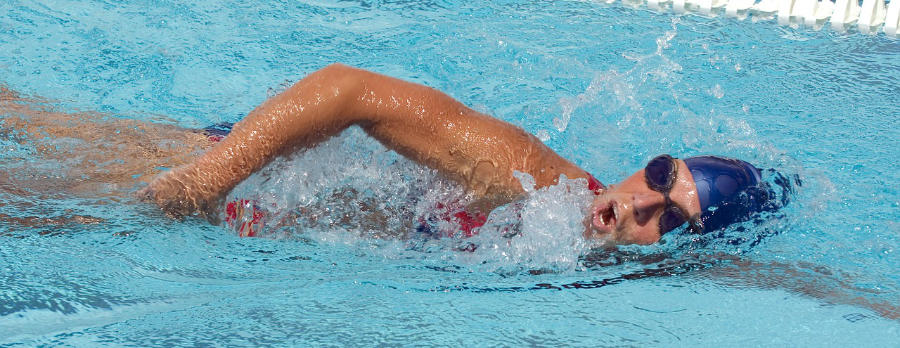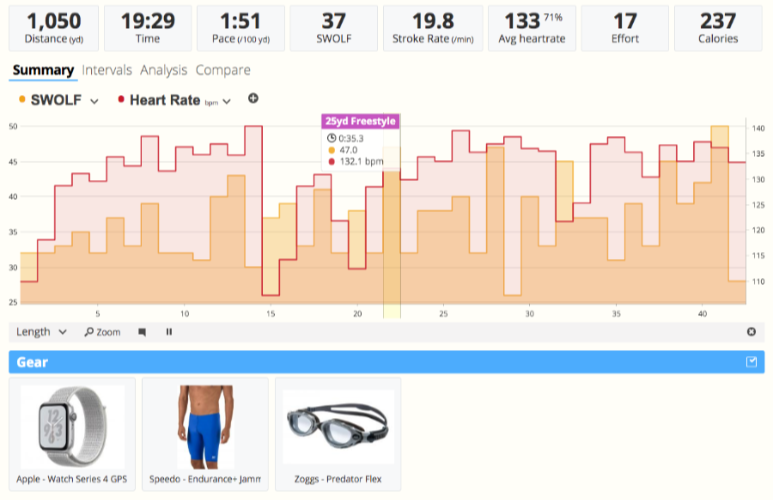Swimming Heart Rate
How to use swim heart-rate data to improve your performance
Heart-rate data is used heavily in both running and cycling, and even if you primarily rely on another metric—like power or pace—heart-rate is still valuable for monitoring ramp-ups and recoveries, trends in your fitness, and anomalies like decoupling. So why isn’t it widely used in swimming? The main problem is that access to underwater heart-rate monitors has been severely limited, but this story has been changing rapidly. At long last, heart-rate data is easy to track in the water, and now we're going to show you how to use it.
The pace clock: born in 1946
Swimmers aren’t historically known for embracing new workout tech. Most lap-pool attendees only use RPE (Rate of Perceived Exertion) and the pace clock, the latter of which is an innovation that arrived 74 years ago. RPE is simply your perception of how hard a workout felt, based on a scale from 1 to 10. The pace clock and RPE are both still quite useful, but why ignore heart rate when it's likely already available on your workout tracking device?

How to use swim heart-rate data
Using heart-rate data in swimming isn't radically different from how it's used in running or cycling. You can intentionally train in specific zones targeting aerobic and anaerobic energy systems separately. Another option is to only utilize heart-rate data in post-workout analysis. For example, you may be following a training plan with workouts based on T-Pace swim zones. As you progress through the plan, your analysis can show if your heart rate is trending lower as you get more fit, helping to verify that the stimulus is being effective.
Your heart-rate zones are going to be significantly lower in swimming than they are in other sports because:
- Water has a cooling effect on your body which improves circulation
- The buoyancy of the water makes you mostly weightless, which means your heart doesn't have to fight gravity as much to circulate blood
- The horizontal nature of swim strokes also helps to reduce the workload of your heart
Depending on your fitness and skill level in the water, your zones should be set 10 to 15 beats-per-minute lower than they are on land. For well-trained swimmers under the age of 19, maximal heart rate will only be 5 to 7 BPM lower. It should be noted that the colder the temperature of the water, the lower your swimming heart-rate zones will be. This is due to a physiological response called The Diving Reflex. Thankfully, most indoor lap pools maintain a consistent temperature all year long, so this may not be a factor you need to consider.
One way to put your swimming heart-rate zones to work is start swapping them out for pace-based portions of established workouts. Swim workouts usually have warmup and cooldown sections. Knowing your zones, you can swim these portions trying to remain in heart-rate zone 2, rather than simply swimming by feel.
Unfortunately, monitoring your metrics in real-time is still a major challenge in swimming, but post-workout swim analysis is excellent on SportTracks. You get dedicated charts based on pool lengths, and metrics like stroke rate, stroke distance, SWOLF, efficiency, heart rate and more.

Equipment for tracking swim heart rate
It wasn't long ago that the only way to track your heart rate in the water was to place two fingers on your neck or wrist during a rest and count the number of beats you felt. Unfortunately, in swim workouts, this manual method is usually plagued with inaccuracy.
In July of 2019, Garmin added underwater heart-rate support using the built-in wrist-worn optical monitor on their popular Forerunner 945 and 245 watches. Every Apple Watch from the Series 2 on has underwater HR-support, and the Polar OH1 and OH1+ both support underwater heart rate as well (the "+" model comes with the required swim-goggle clip).
If accuracy is what you're after, and let's face it, IT SHOULD BE, then the head-worn Polar OH1+ is a good choice. You don't even need to wear a watch with the OH1+, as it can record the workout by itself, and you can easily auto-sync it to SportTracks by linking your Polar account. The OH1+ is also compatible with the Form swim googles, which have a display that lets you monitor your heart rate as you swim. Another great option for accuracy are Garmin's HRM-TRI and HRM-SWIM chest strap monitors.
Is heart-rate data flawed?
Heart-rate data is an imperfect training metric. It's influenced by diet (too much caffeine, not enough hydration, etc.). It's also influenced by lack of sleep and other factors. But as we stated in the beginning of this article, heart rate is still incredibly useful to verify things you may have felt during a workout, and to uncover things in post-workout analysis you may not have felt. For example, after a minute or two of recovery following an intense interval you may feel fine, but your heart rate stays high.
Despite the inherent drawbacks, I still find heart-rate data useful for monitoring portions of a workout that are supposed to be in the easy zones. It's surprising how difficult it is to remain in zones 1 and 2 for extended periods of time. You need to hold back quite a bit to remain in your low zones, and for this reason alone I find heart-rate training both worthwhile and valuable, as imperfect as it may be.
Admittedly, we have a way to go to more formally apply specified heart-rate zone training to the sport of endurance swimming. But there are accurate sensors that are readily available today, and there are useful ways to apply their data to improve your performance. If you're not using every high-quality metric at your disposal, you may not be getting to the finish line as quickly as you could be.
| Article written by Sam Mallery, Director of Marketing, Zone Five Software Inc. |
